THE VILLAGES OF THE CHALKE VALLEY, WILTSHIRE
- Kate
- Apr 16, 2021
- 10 min read
Updated: Jul 28, 2023
In recent years the name of the Chalke Valley has become synonymous with a truly magnificent History Festival, attracting people from across the country and abroad. The Festival itself is a huge attraction for Slow Travellers, but so too is the stunning Wiltshire valley in which it is set.
Here we take a look at the pretty villages of the Chalke Valley; their history, their scenery, their churches and all they have to offer. The Valley is a great area for walking and cycling – there are many footpaths with stunning views and the roads are mostly traffic-free. It is relatively unknown, has unspoilt countryside and is well worth a visit.
The history of the Chalke Valley
The River Chalke itself is a very short river, a tributary of the River Ebble. It rises at Mead End near Bowerchalke and flows just 1.2 miles to join the Ebble at Mount Sorrel, just upstream of Broad Chalke. It’s a typical chalk stream, noted particularly for its brown trout.
The Chalke Valley stretches from Salisbury to Shaftesbury and includes much of the Cranborne Chase Area of Outstanding Natural Beauty with many picturesque villages along both the Chalke and the Ebble. The Ebble rises at Alvediston, joins the Avon at Bodenham and is one of the Fiver Rivers that meet at Salisbury.
There have been archaeological finds of flint tools, pottery, bones and metal objects across the Valley, showing evidence of occupation from the Bronze Age, Iron Age and Roman period. There are also remains of earthworks, barrows and field systems – it is an area rich in early history.
An Anglo-Saxon charter names some of the villages and shows clearly that there were thriving communities here before the arrival of the Norman invaders. The Domesday Book in 1086 divided the Chalke Valley into eight manors and records the change of ownership from Saxon to Norman lords.
By 1536 ownership of “Chalke” had passed to William Herbert, who later became the 1st Earl of Pembroke. His heirs remained lords here until after World War I.
The progress of the Reformation is reflected in the changes shown in the Valley churches. Bullet holes in the West door of Bishopstone Church also indicate that the Valley was affected by the Civil War. War Memorials along the Valley illustrate the sacrifice of men and women of this area in the two world wars.
A visit to these villages also brings awareness of the timelessness of these places. The countryside and fields are much as they were in early times with delightful cottages lining the lanes, and very little in the way of ugly modern buildings.
Alvediston
Alvediston’s prehistory is found in three Bronze Age barrows on Trow Down. By Saxon times Alvediston was part of the land in the possession of the nuns of Wilton, granted to them in 995. The Church of St. Mary was probably founded in the 12th century with the chancel dating from the 13th and the transepts from the 14th century. However, it was extensively rebuilt in the 17th century and then altered again by T. H. Wyatt in the 19th century. The font is believed to be 12th century.
The churchyard has the tomb of Sir Antony Eden, Prime Minister from 1955 – 57. Nearby is Alvediston Manor, a Queen Anne house, his home from 1968 until his death in 1977.
Ebbesbourne Wake
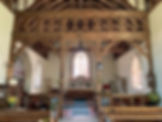
A large hoard of bronze jewellery which included a bronze torc and sixteen bracelets was discovered here in 2012, showing evidence of the early occupation of this area.
A Saxon burial site with a high status Saxon ring was discovered on Barrow Hill and suggests that the Saxons inhabited this valley from early on in their migration.
The village name is believed to come from firstly its location so close to the mouth of the River Ebble, and secondly from a family association with Hereward the Wake, the Saxon noble who resisted the rule of William the Conqueror in the Fens from 1070 – 1071. Hereward the Wake’s coat of arms can be seen on the church tower.
The church of St. John the Baptist was built in the 12th century. The area was devastated by the arrival of the Black Death in the 14th century but by the 15th century had recovered sufficiently to build the church tower, probably from the profits of the local wool industry.
The village did not escape the tensions that came with the Agricultural Revolution – in 1792 2187 acres of land were enclosed, causing great hardship to local people, and 1836 the villagers smashed the threshing machine belonging to the farmer John Rebbeck.
Very little remains of the original 14th century church. The font is Norman and the church tower is 15th century but many changes were made in Victorian times.
Ebbesbourne Wake has a traditional country pub – The Horseshoe Inn. It has one room for accommodation and also boasts a large pretty garden with a fish pond and extensive flower borders. It features regularly in the CAMRA Good Beer Guide and was voted country pub of the year for the Salisbury area inn 2019.
Bowerchalke
The earliest known sign of habitation is the bowl barrow on Marleycombe Down, probably built in the Neolithic or Bronze Age. Two hoards of gold and silver coins have been found, used by the Durotiges, a Celtic tribe who lived here before the Roman occupation. In the 20th century Bowerchalke was home to both Siegfried Sassoon, the First World War poet, and Dr. James Lovelock, originator of the Gaia hypothesis and inventor of the electron capture detector.
Marleycombe Down, Knowle Down and Woodminton Down, known jointly as Bowerchalke Downs, are chalk grasslands along the entire southern outlook of the village. They are designated a Site of Special Scientific Interest with many species of plants, insects and butterflies.
The Church of Holy Trinity dates from the 13th century, with the porch and tower added in the 15th century. The church was restored and enlarged in the Victorian era. The Ten Commandments, which had become prominent in churches following the Protestant Reformation, were removed from the walls and written on boards instead.
Sir William Golding, the author and Nobel Prize Winner, lived in Bowerchalke with his wife Ann for many years. They are both buried in the churchyard. The churchyard also has a Commonwealth War Grave for 2nd Lieutenant Frederick Butler, who lived nearby at Rookhay Farm, a member of the Royal Flying Corps, killed on duty in April 1918 aged 20.
Fifield Bavant
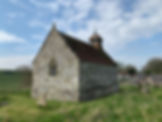
Excavations on Fifield Bavant Down revealed more than 160 storage pits used in the Iron Age to store harvested crops for the years ahead.
The discovery of British and Roman objects, pottery and coins in the same area show that interaction was happening locally. The village was deserted after the Black Death and it is still a tiny hamlet.
It has the smallest church in Wiltshire and reputedly the second smallest in England. The delightful church of St. Martin of Tours dates from the 13th century and the flint and stone walls are almost entirely original, as are the stone cross on the east gable and the lancet window at the north end of the chancel. The turret was added in the early 20th century. It is set up above the valley and has magnificent views across the countryside.
Broad Chalke
Broad Chalke is the largest of the Chalke Valley villages, incorporating the hamlets of Knapp, Mount Sorrel and Stoke Farthing, and hosts the Sports Centre for the Valley. It also has an award winning community local stores, situated in the United Reform Church, which includes a Post Office and coffee shop.
It is here that the Chalke Valley History Festival is held in June, a hugely popular attraction. The Gurston Down Motorsport speed hill climb course is held at Gurston Farm and attracts hundreds of visitors every year.
The village is famous for its watercress beds, situated on a natural spring that rises in the Valley. Rain falling on the hills higher up the valley filters down through the Chalke hills, picking up natural minerals on its way. The watercress is cut daily and sent to London restaurants and markets as well as being available to all through the means of an outdoor fridge and an honesty box set into the wall.
Broad Chalke church was begun in the 13th century but clearly there was worship here before, as parts of a Saxon Preaching Cross have been discovered and are on display inside the church. The chancel has some graphic carvings – a devil, a “Speak No Evil” and an angel playing a stringed instrument among them. More building took place in the 14th century when the lower stages of the tower and the porch were built.
The porch has a fine barrel vault roof and was originally in two storeys. A spiral staircase leads tantalisingly up to what was the priest’s room, now locked. The priest’s desk, pulpit and pews date from the 17th century and are fine examples of wood carving from the post-Reformation period. In the mid 17th century repairs had to be undertaken - John Aubrey in his Natural History of Wiltshire says, “In 1659 Sir John Penruddock and I made ourselves churchwardens, or else the fair church had fallen”.
The churchyard has the tombs of the Reverend Rowland Williams, one of the most influential theologians of the 19th century, Christopher Wood, a celebrated artist of the early 20th century and Sir Cecil Beaton, photographer, diarist, painter, interior, stage and costume designer who lived in nearby Reddish House. The War Memorial stands opposite the Lych Gate, and the small garden area surrounding it was redeveloped for the Millennium.
In September 2021, The Times named Broadchalke in its list of top 50 villages in the UK, which is quite an accolade, and proves just how lovely this small village is.
Bishopstone
Bishopstone consists of 6 hamlets – Croucheston, Faulston, Netton, Flamstone, Throope and Bishopstone. Grim’s Ditch, a territorial earthwork built by Iron Age people around 300 BC forms the southern boundary of the village. In the late Middle Ages the hamlets belonged to the Bishop of Winchester which is where the village derives its name.
The bubbling River Ebble runs through the hamlets, dividing into smaller steams through lakes, around islands and throughout old mills before it becomes one river again as it leaves the village.
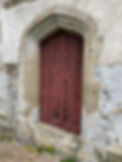
The parish church of St John the Baptist was built between the 13th and 15th centuries, with some restoration carried out in the 19th.
The drama of the Civil War 1642 - 1651 can be witnessed in the bullet holes seen by the West door of the church. Exactly who fired them and for what purpose is unclear. It is known that the rector, John Earle, refused to cease officiating in the church when ordered to do so by Cromwell’s soldiers. Were the shots fired to intimidate him?
Another account suggests that a man was shot here during the Civil War, but the circumstances are unknown.
There are many interesting features, monuments and furnishings inside. The chancel has medieval bosses and corbels with carved flowers, leaves and figures. Some of the figures are crouching as if under the weight of the 14th century vaulted arches of the roof. The chancel also has a medieval triple sedilia, with seats for the priest, deacon and sub-deacon. The North transept has the Founders’ Tomb from the 14th century extending across the whole of the end wall with a richly decorated arch and etched decorations along the top of the tomb.
Correspondingly, in the south transept, is the ornate tomb of the Rev George Augustus Montgomery, designed in the 14th century style by Augustus Pugin. Montgomery was rector here in the 19th century and gave the church the elaborately decorated pulpit and lectern, unusual features in village churches.
There are monuments of interest on the exterior of the building. By the south transept there is a small stone cloister of vaulted bays with a decorated tomb chest. The priest’s door to the chancel is sheltered by an elegant rib-vaulted porch. The path leads from here to the former rectory of the Reverend Montgomery. This magnificent building is thought to have been used by Anthony Trollope as the home of Archdeacon Grantly in the Barchester novels.
There is one Commonwealth War Grave in the churchyard, that of CV Walker of the Australian Infantry who died in 1917, aged 22.
On the main road running alongside the hamlets is the White Hart, a traditional 18th century pub.
Stratford Tony
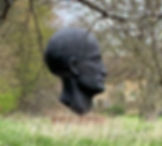
Stratford Tony gets its first name from the “Strat” (Roman road) that ran nearby and the second name from Ralph de Toni, standard bearer to William the Conqueror at the battle of Hastings, to whom the lands were given.
The parish church of St Mary and St Lawrence was built in the 13th century and is now in the care of the Historic Churches Trust.
The gardens of the Manor House are occasionally open to the public.
Coombe Bissett
Coombe Bissett has a particularly attractive nature reserve with sweeping views from the steep slopes above the valley. In spring and summer the slopes are carpeted with flowers which attract many bees and butterflies. The church of St Michael and all Angels dates from 1100 with the present chancel dating from the 14th century and the tower, north aisle and transept are 15th century.
Coombe Bissett has a pub The Fox and Goose which has a spacious bar, terrace and large garden. There is also a village shop and Post Office at Coombe Bissett Stores.
Homington
Homington is a very quiet village with some delightful old cottages. St. Mary’s Church dates from about 1250, the tower being built in about 1500. Restoration work took place in the mid 19th century. An attractive modern feature is the triple lancet east window – a simple but effective cross in delicate pastel colours in stained glass.
The churchyard has a solitary Commonwealth War Grave headstone – to Frederick C Gould, who lived at Totterdown, Pigeons Hill in Homington. An Able Seaman on H.M.S. Challenger, he was killed in the Blitz on London in 1941.
Odstock
There are a number of earthworks in the woods around the village of Odstock, and the name is probably from Odo’s stockade. Odstock Hospital (now Salisbury District Hospital) was established in WWII. From 1943 it was used by the US 5th Army Medical Corps and provided support for the Normandy landings in 1944. Today the hospital is famous for its specialist burns and spinal units.
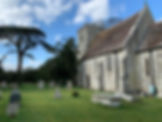
The church of St. Mary comprises a three-bay nave, chancel, west tower and north porch. The chancel is believed to date from the 12th century, remodelled in the 13th, the font and nave are also 13th century. A gravestone in the churchyard marks the burial place of Joshua Scamp, a gypsy who, to protect his daughter, took the blame for his son-in-law’s theft of a horse and was hanged. Legend has it that after Joshua’s death a gypsy curse was put on the church.
What is now the Yew Tree Inn was a pair of 18th century cottages. It has a thatched roof, a heavily beamed interior. There is a large inglenook fire in winter and attractive gardens for the summer. Half mile up the road is Odstock Copse – a spectacular sight in spring with wood anemones, violets, primroses, celandines and bluebells in abundance. The occasional deer can be glimpsed through the trees.
Nunton
Nunton is the village at the extreme eastern end of the Chalke Valley, near to where the Ebble joins the Avon and is overlooked by the ancient defences of Clearbury Ring. There has been a church on the site since Saxon times, and there are still some 12th century stones supporting the chancel arch. However, most of the present building is 19th century.
The oldest established farm is Nunton Farm, a 1200 acre organisation, whose cows can be seen lazily chewing the cud in the fields along the lanes. Some of the milk is sold from the vending machine outside the pub using reusable glass bottles; a highly popular venture with locals and passers by.
The Radnor Arms was originally built as a cottage in the middle of the 18th century. By about 1853 it was a public house, brewing its own beer until 1939. It has an extensive garden with tables overlooking the river; a very pleasant spot for a drink or a meal.






























